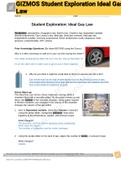Examen
VATI RN COMPREHENSIVE PREDICTOR FOCUSED REVIEW
- Cours
- Exams
- Établissement
- Chamberlian School Of Nursing
VATI RN COMPREHENSIVE PREDICTOR FOCUSED REVIEWManagement of Care – (9) Advance Directives – (1) Legal Responsibilities: Purpose of a Living Will (RM FUND 9.0 Chp 4) A living will is a legal document that expresses the client’s wishes regarding medical treatment in the event the client becomes...
[Montrer plus]












